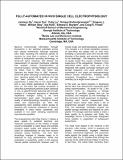Fully-automated in vivo single cell electrophysiology
Author(s)
Go, Jamison; Fan, Aaron; Lu, Coby; Kodandaramaiah, Suhasa Bangalo; Holst, Gregory L.; Stoy, William; Kolb, Ilya; Forest, Craig R.; Boyden, Edward; ... Show more Show less
Downloadaspe 2013.pdf (1.511Mb)
OPEN_ACCESS_POLICY
Open Access Policy
Creative Commons Attribution-Noncommercial-Share Alike
Terms of use
Metadata
Show full item recordAbstract
In this work, we report progress in developing a device that allows fully autonomous sequential patch clamp experimentation. The machine works by integrating a storage magazine of pre-filled pipettes that can be accessed, and swapped, by the headstage at the conclusion of each experiment. In operation, following each neuron measurement, the program enters “swap” state where a set of programmed actuator movements take place. First, the headstage translates towards the pipette storage assembly and deposits its used pipette. The storage assembly rotates to index a fresh pipette, its is grasped, and finally, the headstage returns to its previously designated home position in preparation of subsequent experiments.
Date issued
2013-10Department
Massachusetts Institute of Technology. Media Laboratory; McGovern Institute for Brain Research at MIT; Program in Media Arts and Sciences (Massachusetts Institute of Technology)Journal
Proceedings of the 28th Annual Meeting of the American Society for Precision Engineering
Publisher
American Society for Precision Engineering
Citation
Go, Jamison, Aaron Fan, Coby Lu, Suhasa Kodandaramaiah, Gregory L. Holst, William Stoy, Ilya Kolb, Edward S. Boyden, and Craig R. Forest (2013). "Fully-automated, in-vivo, single cell electrophysiology" in Proceedings of the 28th Annual Meeting of the American Society for Precision Engineering, Saint Paul, MN, Oct 20-25, 2013.
Version: Author's final manuscript